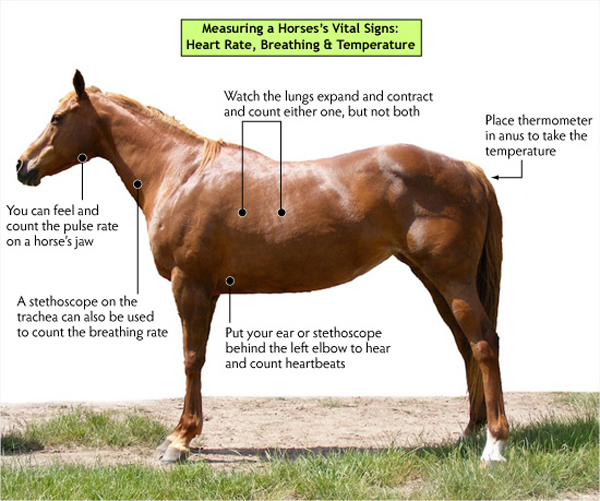Taking Equine Vital Signs
By Brian S. Burks, DVM, Diplomate, ABVP, Board Certified Equine Specialist
Every horse owner should know how to take vital signs. This can help the veterinarian determine the severity your horse’s condition. Noticing that your horse is not feeling its best- off feed, depressed, has colic, etc.- is the first step, but the next is getting temperature, pulse, and respiration.
One way to check the hydration status of the horse is to look at the mucous membranes. Lift the upper lip and observe the color, check for moistness with a finger, and then blanch the gums with your thumb and count the seconds until the (hopefully) pink color returns. This is the capillary refill time (CRT). If you cannot observe the gums, the vulva can be used in a mare, parting the labia. The conjunctiva of the eyes can also be observed for color.
Normal mucous membranes for an adult horse should be pink to light pink and moist. CRT should be two seconds or less. These values are the same for newborn foals. Examples of abnormal mucous membranes include white, gray, or dark purple gums.
Temperature taking requires a digital thermometer that can be purchased at any drug store. Unlike humans, temperature is taking via the anus. Standing to the side and making sure that your horse knows about your presence, lift the tail head to the side. Do not let go of the thermometer. If your horse moves, move with him. Only remove the thermometer after you hear the beep.
Normal rectal temperature for an adult horse averages between 99° and 100.5° Fahrenheit. A newborn foal’s temperature can reach 102° F and still be considered normal.
Heart rate and pulse are generally the same (there are a couple of exceptions) so either can be used. The facial artery can be palpated under the jaw, just on the inside of the bone. Either right or left may be used. A rope-like rubbery structure is the facial artery and the pulse can be felt with a light touch. Use your fingers, not your thumb, so that you do not measure your own pulse by mistake.
If you have a stethoscope, place it just above the elbow and push under the triceps muscle. One heartbeat has two parts “lub-dub”- so do not double count.
The normal heart rate for an adult horse is 28 to 44 beats per minute (bpm). Neonatal foals will be 80-120 bpm. To calculate find the pulse or heartbeat and count for 15 seconds, then multiply by four to get the number of heartbeats each minute. Listening for at least one minute helps determine if the heart rhythm is regular or irregular, or if a murmur is present.
The respiratory rate should be taken with the horse standing quietly. Watch the rib cage go in and out with each breath and count the number in 15 seconds, then multiply by four. Do not hold your hand over your horse’s nose, which may cause sniffing and falsely elevate the rate. A single breath is comprised of both inhalation and exhalation, so do not double count.
The normal respiratory rate is 12-20 breaths per minute. Neonatal foals double that rate at 20-40 breaths per minute.
The equine digestive tract should always be moving and listening to the sounds helps determine how well it is working. This is usually best done with a stethoscope, but sometimes you can hear sounds with your ear against the flank. An inexpensive stethoscope can be purchased at many pharmacies.
Place the stethoscope’s bell onto the upper left side of the horse’s abdomen a few inches behind the ribs and at about level with the hip. Do not move the stethoscope around, just listen in one spot for at least 15 seconds. Then, move the stethoscope to the lower left quadrant: move straight down until you start to reach the curve of the belly. Again, pause here for at least 15 seconds and listen. Repeat on the right side. Listen for up to one minute. If there are no sounds in one minute, the intestinal tract is not moving. The colon is heard on the left side and the cecum on the right side. Small intestinal sounds are not heard as they are in the center of the abdomen.
An average horse, regardless of age, should have an active gut producing a range of different sounds such as gurgles, roars, creaks, whooshes, and tinkles. Listening to the entire gut, you should hear some, or even all, of these sounds. Abnormal gut sounds are ones that are greatly decreased or completely absent. Be sure to listen to all four quadrants. Do not assume that if one quadrant sounds normal, the other three are normal also. Gut sounds can sometimes be hyperactive, indicative of inflammation, but it takes a lot of practice to learn normal from hyperactive.
Obtaining this basic information prior to a phone call to us will help determine the severity of the problem and what might need to be done while you wait for us to arrive.
(724) 727-3481











